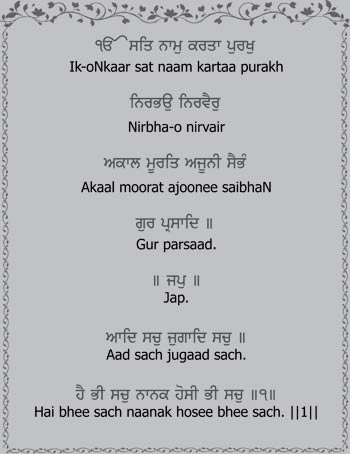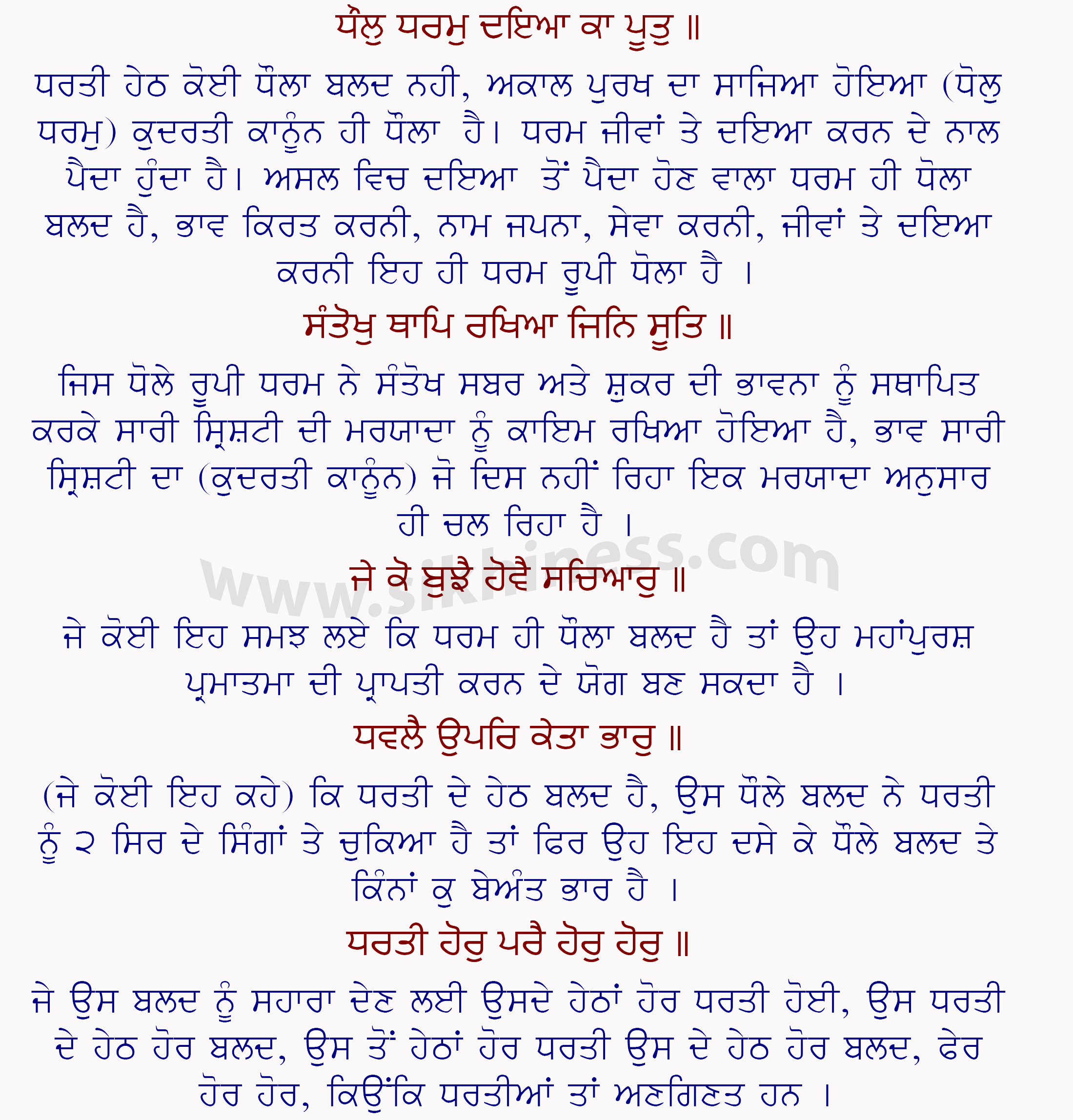Japji Sahib Pdf In Punjabi - skyeypak. Jap ji is a prayer at the beginning of the, considered the holy scripture of Sikhs. It was composed by, the first Guru in the line of ten Sikh Gurus. Jap ji begins with and is followed by 38 pauris (stanzas) and ends with a final at the end of this composition. Japji Sahib Path Pdf. Note: Under development stage. More Banis to be added soon in different formats. The Jaap Sahib is reminiscent of Japji Sahib, and is chronologically recited meaing second, in the daily morning prayer of a Sikh. God is Self controller. Keh sarbun kleemai, keh parmun phaheemai keh aakl alamai, keh sahib klamai.
japji sahib PDF | japji sahib Path Download
- PDF Name Japji Sahib Path
- No. of Pages 37
- PDF Size 0.16 MB
- Language Punjabi
- PDF Category Religion & Spirituality
- Published/Updated April 22, 2021
- Source / Credits sikhnet.com
- Uploaded By Kumar

Japji Sahib is a Sikh hymn, which appears at the start of the Guru Granth Sahib, the sacred scripture of the Sikh religion. It was written by Guru Nanak, the great founder of Sikhism. It starts with Mool Japji and ends with a concluding Salok with Guru Nanak at the end of the composition. Japji is considered to be the most beautiful hymn in the Sikh hymns.
The Japji Sahib should be sung only by a devotee of the Sikh religion. In some cases, Japji sahib has also been prepared for the worship of other non-Sikhs like Hindus. Even though there are some passages from the Japji Sahib that can be recited along with Japji, it is not necessary. It is believed that Lord Brahma created all beings equal. According to Sikh tradition, the Guru is the living guru and the members of his personal council are the non-profit organizations working for the welfare of the Sikhs, their brothers and sisters and the entire Sikh society.
There is a difference between the granth sahib and the holy scripture of the Sikh religion. The granth sahib is just a book, which contains hymns and poems by authors other than the Guru. The Japji Sahib has to be prepared exclusively for the Sikh and is recited under his guidance. The Sikh holy scripture is recited under the guidance of a Sikh master. Some of the famous Japji passages include Baisakhi, Dharam, and Jassa. All these are considered to be the hymns of true spirituality.
Japji Sahib, which is considered to be Guru Nanak’s first composition, is the complete essence of Sikhism. The Sikhs regard it as one of the most important Bani, corsets of verses’ because it is the first Bani from Nitnem. Nanak’s discourse about ‘what is true worship?’ and ‘the nature of God’ is notable. Christopher Shackle says it was created for individual meditative recitation and is used as the first item in daily devotional prayers for the devout. It is used in morning and evening prayers at Sikh gurdwaras (temples). It is also chanted during the cremation ceremony and at the Khalsa ceremony in Sikh tradition.
Japji Sahib Full Path by Harshdeep Kaur
Japji Sahib was my first introduction to the Almighty. Every morning my mother used to hum it for me when I was little. Years later I recited Ik Onkar for Rang De Basanti and received so much love for it.
Japji Sahib, a Sikh prayer that appears at Guru Granth Sahib, is the beginning of Guru Granth Sahib. Guru Nanak, the founder of Sikhism, composed the scripture of Sikhs. It starts with Mool Mantra, then it follows 38 Saudis (stanzas), and ends with a final Salok at its end.
The Japji is just one of many important sections of the Sikh scripture. These include the Ghagh sahib, Gurbani, and the Sarvang Dhajan. The Ghagh sahib is basically a prayer that is performed in the temple at least once a year. This prayer is mainly performed to praise and honor the holy scripture. Sikh gurus consider this prayer to be the most powerful prayer, as it expels all fears and obstructions and causes one to approach the supreme divinity within.
Another important section of Japji is the final salutation. In the Japji Sahib, verses are recited in order, with the first verse last and the last verse first. After the prayer, the follower must stand or sit in a respectful manner and raise both hands. This is to signify that all the evil and destructive forces of nature have been transcended and only the pure and positive energy is now flowing. The Sikh gurus always exhort their followers to raise both hands before they depart from the temple
The Sikhs also recite the hymns as part of the ritual of pujas. However, some mool mantras have a different significance than the rest. For example, the mool mantra of Gudai Nanak says “Ras lee se! We have come to Earth from the sky/soil.” On the other hand, the Gurkha mantra of Gudai Nanak says “Nam eoge giit sagal”. These two verses clearly show that the difference between the two is that the Gurkha mantra invokes ascetic discipline while the Nanak’s hymn is an idealistic and fun way to rejoice.
While some Gurus prescribed certain number of mantras for Japji Sahib, there are a few who allow the followers to choose as they wish. However, the important thing here is that the followers should choose the Japji Sahib chant which brings them closer to the Lord. The best Japji Sahib chant for the disciples is one which is simple, pure and mystical. However, this is not the case most of the time and the followers often recite the same old Japji Sahib chant without any change.
Every sect of Sikhs has their own Japji Sahib chant. However, the followers of Guru Gobind Singh had a specific chant that they recited at their guru sahib’s funeral prayers. Most of these followers of guru Gobind Singh had changed the chant by now and after him there were few who wanted to maintain the old tradition. Even today, Japji Sahib took place with the same reverence and fervour as it did hundreds of years back.

Related
Download Japji sahib in Original Gurmukhi only in pdf format · Download Japji sahib in Original Gurmukhi, Roman transliteration and. Download Gurbani PDF files for free, which you can use on any device that supports PDF files. Japji Sahib- Gurmukhi · Japji Sahib-English Translation · Jaap. Jap ji is a prayer at the beginning of the Sri Guru Granth Sahib, considered the holy scripture of First published in, Adi Granth, Language, Gurmukhi.
| Author: | Shaktitaxe Samuro |
| Country: | Antigua & Barbuda |
| Language: | English (Spanish) |
| Genre: | Literature |
| Published (Last): | 27 July 2009 |
| Pages: | 198 |
| PDF File Size: | 3.51 Mb |
| ePub File Size: | 9.13 Mb |
| ISBN: | 481-8-74811-669-8 |
| Downloads: | 25741 |
| Price: | Free* [*Free Regsitration Required] |
| Uploader: | Daijind |
Gurbani PDF – Sikh Zone
Added page to page navigation by ‘Prev’ and ‘Next’ buttons – no need to go back to main page after each section. With good karmas in past life and His grace is the gate of mukti liberation is found; in Him is everything, states Hymn 4. Bhajans by Sri Sathya Sai 2. This app has been created gudmukhi my son Manav Bhalla as our respect towards the Sikh faith.

Sikhism history beliefs Sikh. From Wikipedia, the free encyclopedia.
Downloads > Gurbani PDF
Bhajans by Sri Sathya Sai. Part of a series on. Each page after the index page has ‘Next’, ‘Prev’ and ‘Index’ buttons. Sundar Gutka Sahib Audio.
Any discrepancy, error or concern can be notified via email to hinduapps yahoo. Japji Sahib in 3 Languages.
Japji Sahib – Wikipedia
By using this site, you agree to the Terms of Use and Privacy Policy. Jap ji begins with Mool Mantra and is followed by 38 pauris stanzas and ends with a final Salok at the end of this composition.
In Jap ji it is stated that God is indescribable; the only true form of worship is worship of Nam inner Word, Sound, Powerrealization of God, and to remain always in the Holy Will of that loving God, accomplished with the grace of the True Guru. Related to Jap ji is the Jaapu Sahib Punjabi: You can return to the index page from any page by clicking on the ‘Index’ button. Japii is chanted in the Sikh tradition at the initiation ceremony and during the cremation ceremony.

Retrieved from ” https: Sri Guru Granth Sahib Ji.

Japji Sahib Pdf Full
Khalsa Sundar Gutka contains the daily and extended Sikh Prayers. Hymns 21 through turmukhi revere the nature and name of God, stating that man’s life is like a river that does not know the vastness of ocean it journeys to join, that all literature from Vedas to Puranas speak of Him, Brahma speaks, Siddhas speak, Yogi speaks, Shiva speaks, the silent sages speak, the Buddha speaks, the Krishna speaks, the humble Sewadars speak, yet one cannot describe Him completely with all the words in the world.
After you are done with one sayib, just click the ‘Next’ button to go to the next page or ‘Prev’ button gur,ukhi go to the previous page. God is the primal one, the pure light, without beginning, without end, the never changing constant, states Hymn Notable is Nanak’s discourse on ‘what is true worship’ and what is the nature of God’. Bhajans by Sri Sathya Sai 1.
Outline of Sikhism Sikhism portal. Yoga Poses for Beginners.
The app displays gjrmukhi Mool Mantra, 38 hymns and the final Salok as individual icons on the main page. Japji Sahib consists of the Mool Mantra as the beginning followed by 38 hymns and a final Salok at the end of this composition. Views Read Edit View history. This page was last edited on 31 Decemberat Hymns 6 to sahbi describe the value of listening to the word and having faith, for it is the faith that liberates. Once an icon is clicked – you can read the corresponding text in gurmukhi and if you would like to listen to the audio, you can click on the ‘Play’ button.
Jap ji is believed to be the first composition of Guru Nanak, and is now considered the comprehensive essence of Sikh faith. Account Options Sign in. The Japji Sahib opens with hymn that ‘one cannot clean the mind just by cleaning the body, by silence alone one cannot find peace, by food alone one cannot satisfy one’s hunger, to be purified one must abide in love of the divine’.
Japji Sahib Pdf English
Jap ji is a prayer at the beginning of the Sri Guru Granth Sahibconsidered the holy scripture of Sikhs.
Also provided are the ‘Play’ and ‘Pause’ buttons for the audio. Hymn 30 states that He watches all, but none can see Him. The Japu Sahib includes a mention of God as wielder of weapons, consistent with the martial spirit of Dasam Granth.